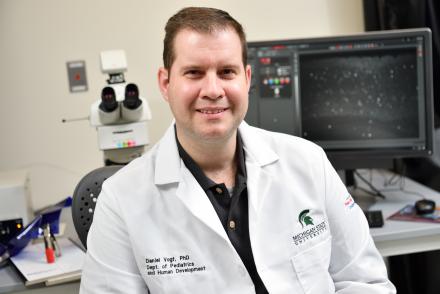A new study published in Nature Communications on a rare genetic disease provides insights into autism, epilepsy and cognitive impairment.
The disorder, tuberous sclerosis, causes benign tumors on the skin and multiple organs, including the heart, kidneys and lungs. About half of people with tuberous sclerosis also have autism spectrum disorder and roughly 90% have seizures.
Tuberous sclerosis is caused by mutations in two genes, which are critical to a pathway that restrains an important protein found in several disorders with high rates of autism. Pathways are a series of actions that lead to something being produced, like protein, or a change in a cell. Pathways also control our response to the world; examples include a fertilized egg that develops into a baby, or how we maintain balance.
But faulty pathways can spark diseases. In this case, the tuberous sclerosis genes are causing autism, according to Daniel Vogt, lead author and assistant professor in the Department of Pediatrics and Human Development, MSU College of Human Medicine.
“Tuberous sclerosis is caused by mutations in two genes that turn off a protein called ‘MTOR,’” Vogt said. “When MTOR is on at the wrong times, autism is a consequence. Understanding how MTOR regulates development and function of brain cells is important in understanding both how autism develops and the neuropsychiatric symptoms of tuberous sclerosis.”
As part of the study, Vogt and his team created knockout mice that lacked TSC1, one of the two genes responsible for tuberous sclerosis. The scientists found that certain cells had higher levels of MTOR. The team validated these findings by comparing them to other mice that still had the TSC1 gene.
“This analysis made clear MTOR is really important in the pathway,” Vogt said. “This was really a big surprise for the field.”
The team also found that in mice without the TSC1 gene had an imbalance in normal brain activity that causes seizures. The authors believe this may contribute to the relatively high likelihood of epilepsy in individuals with tuberous sclerosis.
Finally, the researchers showed that the problem in the pathway was reversible with treatment.
“We wanted to see if we could rescue – that is, reverse the neuronal changes we had observed in the mice lacking the TCS1 gene,” Vogt said. “We gave rapamycin to adult animals, a drug to block MTOR, and indeed saw that with five days of treatment, we could reverse most of the changes.”
Rapamycin is already on the market, sold under the tradename Sirolimus, which is used to prevent organ transplant rejection and treat skin lesions. The new results suggest that the altered pathways by the TSC1 gene may not be permanent and that these existing treatments may one day be used to reverse them.
Vogt said the results are encouraging since they offer clues not only about tuberous sclerosis, but also about the molecular origins of epilepsy and autism.
“We can see the actual biological changes in the brain,” Vogt said. “We’ll next look at human brain tissue and observe whether the same things are happening, but these results are very encouraging.”
Additional researchers in Vogt’s lab who contributed to the study are April Stafford and Kartik Angara. Additional authors on the study are Ruchi Malik, Emily Ling-Lin Pai, Anna Rubin, Petros Minasi, John Rubenstein and Vikaas Sohal, all of the University of California, San Francisco.


